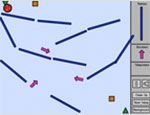
You will use your learning from the Design Technologies project in Term 1 where you designed and constructed a marble run on a plate. You will take these concepts into a digital environment, using Scratch, where you will design and program an interactive digital marble run game with multi levels.
Learning Intentions
I am learning to…
- design algorithms to provide a solution to a digital challenge,
- include repetition, branching and design a user interface in a visual program.
Success Criteria
I will be successful when I…
- create, develop, communicate and document design ideas using appropriate technical terms and graphical representation techniques,
- analyse and modify design ideas to improve the solution.
- troubleshoot and debug coding issues.
To learn this I will…
Use Scratch to create an online Marble Game with more than one level.
Play
Explore:
Ideas
The Amazing Marble Race + more to check out.
Plan
Design each level before you begin to code it.
Start simply and increase the level of difficulty slightly in each level.
Decide what features you will include.
Create
Log into Scratch. Go to My Stuff. Select New Project.
Name your project: Marble Maze Game.
Help
How to make levels in your Scratch game 1
How to make levels in your Scratch game 2 [Using Broadcast]
For the Teacher
Australian Curriculum Digital Technologies Years 5-6
Learning Intentions
Students will learn to…
- define problems in terms of data and functional requirements,
- design solutions by developing algorithms,
- incorporate decision-making, repetition and user interface design into their solutions using a visual program.
Success Criteria
Students will demonstrate their learning when they…
- define problems in terms of data and functional requirements drawing on previously solved problems,
- design a user interface for a digital system,
- Design, modify and follow simple algorithms involving sequences of steps, branching, and repetition,
- implement digital solutions as simple visual programs involving branching, repetition, and user input.
